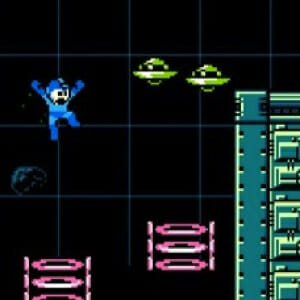Mega Man 9 (Wii)

No one in my generation who grew up playing video games needs to be reminded that the production qualities and technological muscle of contemporary video games have reached once-unimaginable levels. There was a time back in the halcyon 8-bit days of yore when too many Octarocks crawling around the screen in Legend of Zelda caused your game to lapse into a lurching slow-motion cadence until things cleared out a bit. You could practically hear Scotty’s muffled brogue coming from inside your NES console: “I’m givin’ her all she’s got, Cap’n.” And ‘all she had’ was enough. We were too busy enjoying ourselves to care.
Today’s a different story. Contemporary game studios demand technical perfection. And silky frame-rates in next-gen titles ensure that animations seamlessly unfold. An obviously buggy slow-down in the action would likely cost a few designers their jobs. In the options menu for Capcom’s downloadable title Mega Man 9, you have the option of toggling on legacy affectations that good-naturedly mimic some of those familiar glitches from back in the day. Screen sprites—misfiring individual pixels in the display—will flicker occasionally like distant stars. While it seems a bit gimmicky to design a 2008 release in a defiantly traditional 8-bit style, the effect is one of pure joy and elegant simplicity.
Capcom’s use of simulated imperfections in Mega Man 9 feels like the gaming equivalent of a recording engineer going into his studio’s state-of-the-art ProTools rig and adding record crackle to a newly minted track. The nostalgic charm of those subtle imperfections becomes part of the allure. I actually prefer listening to the older, scratched-up records in my vinyl collection—The Four Tops, The Beatles, Stevie Wonder. The crackle of the needle jumping those scratches warms the soul like the sound of wood burning in a campfire. Bob Dylan’s voice ain’t perfect, but it’s also one of a kind. So what if the man has an 8-bit croon? He uses it to great effect, just like Mega Man creator Keiji Inafune and his team do with the so called “limitations” of midi music and slightly beefier pixels.
-

-

-

-

-

-

-

-

-

-

-

-

-

-

-

-

-

-

-

-

-

-

-

-

-

-

-

-

-

-

-

-

-

-

-

-

-

-

-

-








































